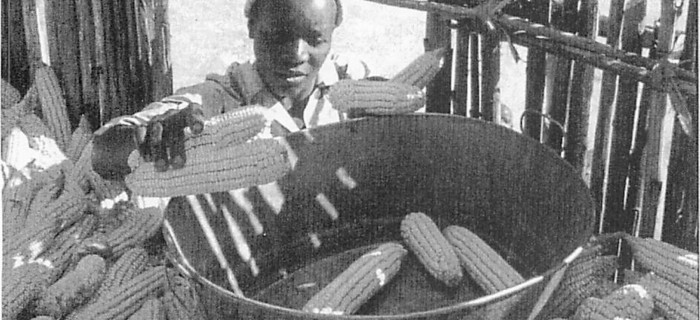The Profits of Famine: Southern Africa’s Long Decade of Hunger
Food First Backgrounder, Fall 2002, Vol. 8, No. 4
At the end of September, Colin Powell requested an altogether earthly intercession from Archbishop Jean-Louis Tauran, the Vatican foreign minister. The Secretary of State wanted the Vatican to persuade the Zambian government to accept US-supplied genetically modified (GM) food aid. With a population under 10 million and with the vast majority of people earning under $ 1,000 a year, Zambia is a mouse that has roared. In refusing to accept U.S. GM corn, and by dealing with its famine by sourcing grain from within the region, the Zambian government has sent a clear signal that it understands both why famines happen and that U.S. aid is part of the problem, not the solution. By the end of 2002, a little under 15 million people will have faced starvation in Southern Africa. Lesotho, Malawi, Mozambique, Swaziland, Zambia, and Zimbabwe are among the most severely affected. Thus, while the U.S. State Department blames the Zimbabwean government for the famine there, that explanation is clearly inadequate to account for a famine that has affected the entire region. For a meaningful explanation, we need to understand what a famine means, and put it into the context of a phenomenon that has affected the entire region-structural adjustment.
How to Define a Famine
Definitions of famine run a gamut. The World Health Organization (WHO), for example, declares a famine when “the severity of critical malnutrition levels exceed 15 percent of children aged 6 to 59.9 months.” The UN’s food and Agriculture Organization (fAO) defines famine as “an extreme collapse in local availability [o~ and access to food that causes [a] widespread rise in mortality from outright starvation or hunger-related illnesses.” These definitions focus on the threshold a situation crosses in order for chronic hunger to be officially declared acute. But this threshold is essentially arbitrary. for example, because rates of acute malnutrition have remained stable in most Southern African countries, the WHO has nor yet declared a stare of famine in every country.
Mike Davis, who has written on famine in recent history, points us away from this sort of threshold thinking: “We must acknowledge that famine is part of a continuum with the silent violence of malnutrition that precedes and conditions it, and with the mortality of the shadow of debilitation and disease that follows it.” Famine does not arise spontaneously with the failure of a harvest season; rather it is the outcome of a system that places greater importance upon the market than upon those going hungry.
The Silent Violence of Malnutrition
It’s no wonder the people of Southern Africa are starving in 2002—they have been starving for over a decade. The Southern African Development Community reports that in Zambia in 1991, the chronic malnutrition (stunting) rate of children between the ages of 6 and 59 months was 39 percent. Since then it has increased to (and leveled off at) about 55 percent. At the same time, acute malnutrition (wasting) rates have thus far remained stable at 4.4 percent in Zambia. In Malawi, the rate of chronic malnutrition has remained at 49 percent since 1990. It is only acute malnutrition that has slightly increased over the same period, by 1 percent for a total rate of 6 percent. The United Nations Development Programme (UNDP) estimated in 2000 that 35 percent of the people in the famine region were undernourished, with 54 percent of Mozambique’s population undernourished. Among those most vulnerable to chronic hunger are women, children, and the elderly. The UNDP reported in 2000 that 20 percent of children in the region under the age of five were underweight.
Stay in the loop with Food First!
Get our independent analysis, research, and other publications you care about to your inbox for free!
Sign up today!In 2002, rampant Southern African hunger was tipped over the official “famine” threshold by two years of bad harvests. That’s one reason we’re now hearing news of it. Another likely reason is that some Southern African countries aren’t behaving as the U.S. would want them to, and the word “famine,” with the desperate urgency it conveys, helps put pressure on those governments. That sense of emergency also masks the question we must ask: why, even before the current food crisis, have so many people suffered for so long from chronic malnutrition?


 Help Food First to continue growing an informed, transformative, and flourishing food movement.
Help Food First to continue growing an informed, transformative, and flourishing food movement.




